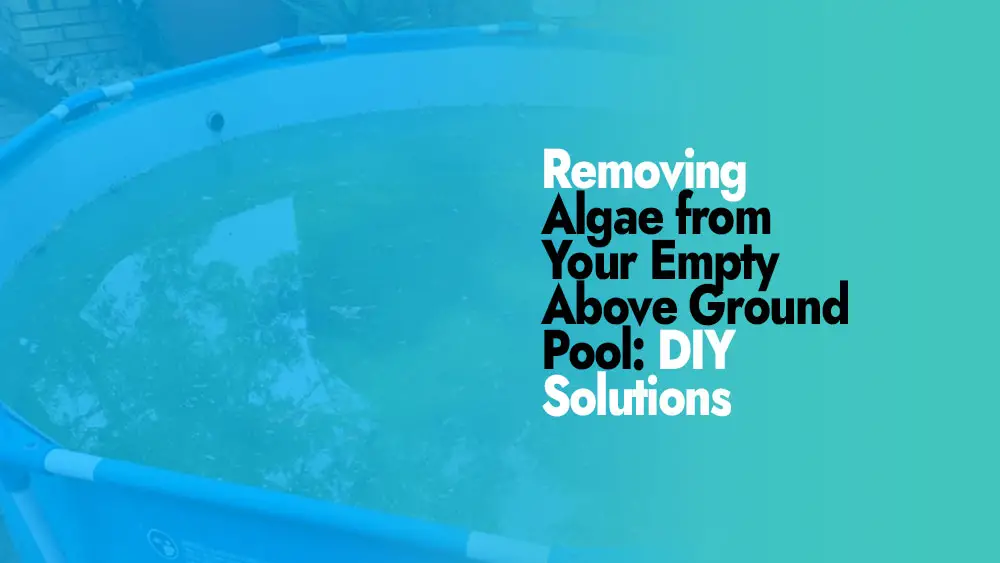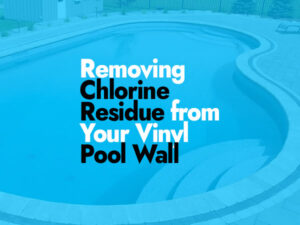Keeping an above-ground pool clean can be fun, but algae can quickly make it hard and annoying. I’ve found amazing do-it-yourself ways to get rid of this green pest through trial and error. In this post, I’ll share what I’ve learned the hard way with other people who own pools.
Algae can turn a nice pool into a nasty mess, but you don’t have to pay a lot for professional help. With a few simple things from around the house, some hard work, and patience, you can stop algae growth in its tracks. I’ll show you some easy-to-do-it-yourself ways to get rid of algae in your empty above-ground pool. Let’s roll up our sleeves and make your backyard oasis shine again!
DIY Ways to Get Rid of Algae in an Empty Above-Ground Pool
Keeping your above-ground pool clean and free of algae is important if you want it to last a long time and be a safe place to play. Algae can grow in an empty above-ground pool, but there are some easy-to-do things you can do to get rid of it. We’ll look at eight tried-and-true ways to get rid of algae in your pool.

A Solution of Vinegar and Water
Using a mixture of vinegar and water is an easy solution that works well. Because vinegar is acidic, it kills algae without hurting the Earth. Mix one part vinegar with three parts water, and then spray the mixture on the places where the algae is growing. After about 20 minutes, use a brush to clean the walls and floor of the pool. Use clean water to wash it well.
Bleach Treatment
Bleach is a strong cleaner that can be used to stop green growth. Mix 1/2 gallon of bleach with 5 gallons of water to use bleach as a do-it-yourself option. Use a brush to clean the algae-covered areas with a lot of the solution. Let the bleach sit for about 15 minutes, and then fully rinse the pool. Be careful when using bleach, because it could change the pH balance of the pool.
Baking Soda and Brushing
Baking soda is a useful item around the house that can also be used to get rid of algae in your pool. Sprinkle a lot of baking soda on the areas with algae, especially on the floor and walls. Then, scrub the surfaces well with a pool brush. Baking soda is a rough cleaner that can help get rid of algae and spots. Rinse the pool with water after cleaning to get rid of any leftover dirt.
Hydrogen Peroxide
Hydrogen peroxide can be used instead of strong chemicals to get the job done. Because it gives off oxygen, it can help kill algae without hurting the environment. For every 500 gallons of water in your pool, add 1 to 2 cups of 3% hydrogen peroxide. Spread the peroxide around the pool equally and let it sit for 24 hours. Then, brush the sides of the pool to get rid of the dead algae, and then drain and rinse the pool well.
Pool Shock Treatment
Most of the time, pool shock treatments are used to clean and sterilize the water, but they can also be used to get rid of algae in a pool that isn’t being used. Follow the directions on the package of shock treatment to figure out how much you need for your pool size. As directed, mix the shock treatment with water and spread it equally across the pool. Let the shock treatment work overnight. The next day, brush and rinse the pool.
Chlorine and Sunlight
Algae grow well in the sun, so using the sun’s power can help get rid of them. Fill your empty pool with water and put it in a sunny spot for a few days so that the water can get full sunlight. This will help algae die off in a normal way. Also, adding bleach tablets to the pool will protect it from algae growth in another way. Check the chlorine amounts and make changes as needed.
Pool Enzyme Treatment
Algae can’t grow in your pool if you treat it with enzymes that break down organic waste. Look for enzyme items that are made to get rid of algae in pools. Follow the manufacturer’s directions, which usually say to spread the enzyme treatment evenly across the pool. Give the enzymes the time they need to work, and then brush and rinse the pool to get rid of the dead algae.
Manual Removal
For bigger or more stubborn patches of algae, it may be necessary to remove them by hand. Use a pool cleaner or net skimmer to physically remove the algae from the pool’s surfaces. Make sure to pick up all the obvious algae and keep it from going back into the pool. After removing the algae by hand, use a normal cleaning method to stop it from coming back.
In conclusion, there are several effective do-it-yourself options you can try if you find algae in your empty above-ground pool. From vinegar and bleach to baking soda and hydrogen peroxide, these ways offer alternatives to harsh chemicals that are better for the environment. When using any cleaning solution, make sure to always follow the directions carefully and take the right safety steps. By cleaning and taking care of your above-ground pool on a regular basis, you can make sure it stays clean and algae-free.
FAQs
Are these things I can do myself safe to use in my above-ground pool?
Yes, most of the time, these do-it-yourself fixes are safe for above-ground pools. But it’s important to carefully follow the directions and use the right amounts. Make sure the answer works in a small area first before putting it in the whole pool.
How long do the do-it-yourself methods take to work?
Depending on how bad the algae is, the DIY methods may take different amounts of time to work. Most of the time, you should see effects within a few hours to a few days. But if the problem keeps coming back, you may need to do the treatment again or try a different way.
Can I mix different do-it-yourself fixes to make them work better?
Some DIY methods can be used together, but you should be careful. When you mix certain chemicals or substances, bad things can happen. It’s best to use only one solution at a time and follow the directions that come with it.
Will these things I can do myself hurt the surface or tools of my pool?
When used the right way and in the right amounts, these do-it-yourself methods shouldn’t hurt the surface or equipment of your pool. But using too much of some products or being exposed to them for a long time can cause damage. After treating the pool, you should always give it a good rinse to get rid of any residue.
Can I use these do-it-yourself methods to clean an already-filled pool?
No, these do-it-yourself methods are made to clean an above-ground pool that is empty. The chemical balance changes when the pool is full of water, so the treatments may not work as well. Before you try any of these do-it-yourself treatments, it’s best to drain the pool.
How often should I use these things I can make myself to stop algae from growing?
How often you use these do-it-yourself methods depends on things like the weather, how often you use your pool, and how well you take care of it. As a general rule, it’s best to clean your above-ground pool and take preventative steps like keeping the chlorine level at the right level and brushing it every week.
Can I use these do-it-yourself options for other types of pools, like in-ground pools?
Some of these do-it-yourself options may work for other types of pools, but it’s important to think about the pool’s needs and features. For example, in-ground pools may have different surfaces and filtering systems that need to be cleaned in different ways. For cleaning other types of pools, check the manufacturer’s instructions or talk to an expert.
How can I stop algae from growing in my above-ground pool to begin with?
Algae won’t grow in your above-ground pool if you take care of it regularly. This means keeping the water’s chemistry right, brushing the pool’s surface often, and making sure there is enough filtration and movement. Algae can also be stopped by using the pool cover correctly, keeping the pool out of the sun, and getting rid of trash quickly.
Are there any DIY ways to get rid of algae that are harmless or good for the environment?
Yes, vinegar, baking soda, and hydrogen peroxide are all examples of natural or environmentally friendly options to harsh chemicals. These solutions can be used to get rid of algae without hurting the earth too much.
What should I do if DIY methods don’t solve the algae problem?
If you try to fix the algae problem yourself and it keeps coming back or gets worse, it may be time to call an expert. A professional who takes care of pools can look at the situation, figure out what’s going on, and give you specialized treatment to get rid of the algae and get your pool back to a clean and healthy state.
Can I Use DIY Solutions for Removing Algae from my Pool Without a Vacuum?
If you’re wondering if DIY solutions can effectively remove pool algae easily without a vacuum, the answer is yes! There are various techniques, such as using algaecides, brushing the affected areas, and maintaining proper water chemistry. However, it’s important to consult with experts or follow instructions carefully for optimal results.
Conclusion
In conclusion, there are effective and environmentally friendly ways to get rid of algae in your empty above-ground pool that you can do yourself. With regular care and home remedies like vinegar, bleach, baking soda, and hydrogen peroxide, you can keep your pool clean and algae-free. This will make swimming more fun.







